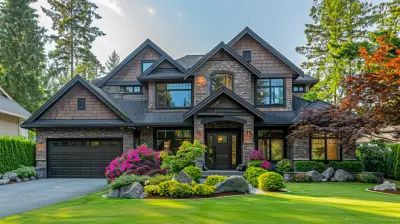How Demographics Influence the Value of Commercial Properties
2 November 2025
When it comes to investing in commercial real estate, most people focus on location, market trends, and economic conditions. But there’s another crucial factor that often gets overlooked—demographics. Who lives in an area, their income levels, education, age, and lifestyle preferences all play a massive role in determining the value of commercial properties.
Think of it this way: would a luxury shopping mall thrive in a low-income neighborhood? Probably not. Would an office building in an area full of remote workers be as valuable as one in a corporate hub? Unlikely. That's why understanding demographics isn't just helpful—it’s essential for making smart investment decisions.
In this article, we’ll break down how different demographic factors influence commercial property values and what investors should keep in mind before making a move.

1. Population Growth and Density
Why Does Population Matter?
In simple terms, more people mean more demand. If an area is experiencing rapid population growth, businesses will want to move in, increasing demand for commercial properties. On the other hand, if people are leaving a city, property values can take a hit.Urban vs. Rural Markets
Urban areas tend to have higher property values due to dense populations and increased economic activity. Rural or suburban areas, while often more affordable, may not see the same level of demand, keeping commercial property prices lower. However, with remote work on the rise, some suburban areas are seeing increased interest, boosting property values.
2. Age Demographics and Their Impact
Young Professionals (Millennials & Gen Z)
Younger generations tend to favor mixed-use developments, co-working spaces, and trendy retail hubs. If an area has a high concentration of young professionals, properties that support entertainment, cafes, gyms, and flexible office spaces are likely to thrive.Middle-Aged Demographics
People in their 40s and 50s typically prioritize convenience and stability. Commercial properties in areas with a high concentration of this age group may see strong demand for shopping centers, healthcare facilities, and office spaces.Retirees and Seniors
Areas with significant senior populations need medical offices, assisted living facilities, and convenience-based retail. Investing in commercial properties that cater to senior citizens can provide stable, long-term returns, particularly in areas with aging populations.
3. Income Levels and Spending Power
High-Income Areas
Wealthier populations support high-end retail stores, luxury offices, and upscale dining establishments. Commercial properties in affluent neighborhoods often demand premium prices due to strong consumer spending.Middle-Class Neighborhoods
Most commercial properties thrive in middle-income areas since they balance affordability with purchasing power. Shopping centers, grocery stores, and family-oriented businesses usually do well in these regions.Low-Income Communities
Properties in lower-income areas often struggle with lower rental yields and business turnover. However, strategic investments in discount retailers, essential services, and affordable housing developments can still be profitable over time.
4. Employment Trends and Job Diversity
White-Collar vs. Blue-Collar Markets
The type of jobs in a given area impacts the value of commercial properties. White-collar job hubs, such as tech or finance districts, drive demand for office spaces, high-end retail, and premium dining. Meanwhile, blue-collar job concentrations support industrial spaces, warehouses, and budget-friendly retail.Unemployment Rates
High unemployment can lead to business closures, reducing demand for commercial properties. On the flip side, areas with strong job growth attract businesses and investors, driving up property values.5. Education and Skill Levels
How Education Affects Property Demand
Highly educated populations often have higher disposable incomes, supporting businesses like bookstores, coffee shops, and coworking spaces. Cities with top universities typically attract investments in student housing, office spaces, and hospitality-related businesses.Skilled Workforce and Innovation
Regions with a high concentration of skilled workers (such as Silicon Valley) create hotspots for commercial real estate investments. Office spaces tailored to startups and tech companies tend to perform well in these areas.
6. Consumer Preferences and Lifestyles
Shopping and Dining Trends
Consumer behavior affects retail spaces significantly. Younger populations favor experience-based businesses—such as entertainment venues, niche fitness centers, and gourmet food markets. Meanwhile, older generations may lean towards traditional shopping malls and grocery stores.The Rise of E-commerce
With online shopping growing rapidly, demand for warehouses and distribution centers has increased, while brick-and-mortar retail spaces have faced challenges. Investors need to consider how shifting consumer habits impact commercial property values.7. Transportation and Infrastructure
Access to Public Transit
Areas with strong public transportation networks tend to have higher commercial property values. Easy access to trains, buses, or major highways increases foot traffic, benefiting businesses and attracting tenants.Parking Availability
In car-dependent areas, ample parking spaces are crucial. A retail center with limited parking in a suburban neighborhood is less appealing, while a well-located commercial property with plenty of parking can command higher rents.
8. Crime Rates and Safety
The Impact on Property Values
Higher crime rates can deter businesses and investors, leading to lower commercial property values. Safe neighborhoods, on the other hand, attract more foot traffic, boosting the demand for retail spaces, offices, and mixed-use developments.Gentrification and Community Development
Some areas with previously high crime rates experience revitalization through gentrification. When this happens, commercial property values can soar as businesses and residents move in. Savvy investors often spot these trends early for profitable opportunities.9. Cultural and Ethnic Composition
Cultural Business Districts
Some areas develop strong cultural identities—such as Chinatown or Little Italy—which can significantly impact commercial real estate demand. These neighborhoods attract tourists and residents alike, making them ideal for restaurants, specialty retail, and hospitality businesses.Language and Communication
Businesses in multilingual neighborhoods may require bilingual staff, affecting the types of companies that thrive there. Investors should consider cultural dynamics when selecting commercial properties to ensure alignment with market demand.
Conclusion
Demographics are a powerful force that directly shapes the demand, value, and long-term potential of commercial properties. From population growth to income levels and lifestyle trends, understanding these factors can make or break an investment.If you're considering investing in commercial real estate, don’t just look at the property itself—study the people who live and work in the area. After all, real estate isn’t just about buildings; it’s about the people who use them.
all images in this post were generated using AI tools
Category:
Commercial Real EstateAuthor:

Vincent Clayton
Discussion
rate this article
1 comments
Jet McCarthy
Great insights! It's fascinating how demographics shape the commercial real estate landscape. Understanding community needs and trends can really help investors make informed decisions. As neighborhoods evolve, so do property values. It's a reminder of the ever-changing dance between people and space!
November 15, 2025 at 5:52 AM

Vincent Clayton
Thank you! I'm glad you found it insightful. Understanding demographics is indeed crucial for navigating the dynamic commercial real estate landscape.


